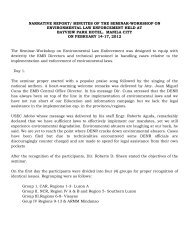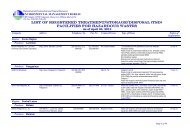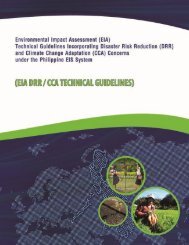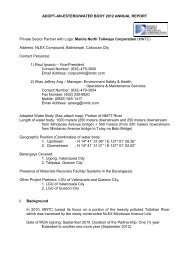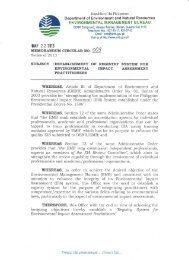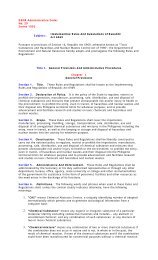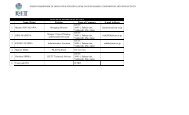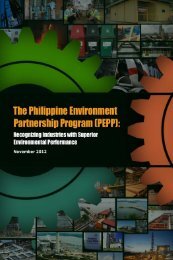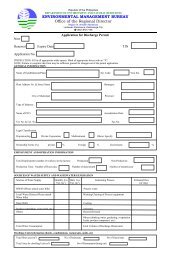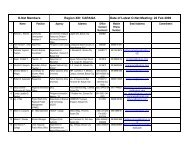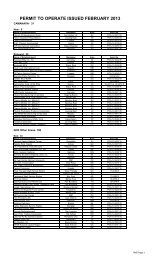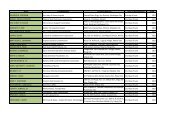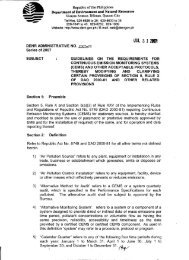Bicol Integrated Fiber Coconut Processing Project
Bicol Integrated Fiber Coconut Processing Project
Bicol Integrated Fiber Coconut Processing Project
You also want an ePaper? Increase the reach of your titles
YUMPU automatically turns print PDFs into web optimized ePapers that Google loves.
<strong>Bicol</strong> University Focus<br />
Facts about <strong>Bicol</strong> <strong>Coconut</strong> Farmers<br />
• <strong>Coconut</strong> Farmers Form<br />
The Biggest Poverty Group<br />
• Income From Copra is P900-<br />
P1000 per hectare/month<br />
• With 2 Hectare Ave. per<br />
Family of six, Income per<br />
month is P2,000
Facts about <strong>Coconut</strong><br />
•Largest Farm<br />
Waste in the<br />
Country<br />
•8 Billion Husks are<br />
burned or thrown<br />
away<br />
• 4 Billion Used<br />
as Fuel to<br />
Make Copra<br />
Husks
Transforming Husks Into<br />
Useful Materials<br />
• Furniture and Molded<br />
Products<br />
• Gardening and Agriculture<br />
• Insulation Materials<br />
• Building Materials<br />
• Erosion Control and<br />
Bio-Engineering
RESEARCH AND EXTENSION FUNDING<br />
DIFFICULTIES OF REGIONAL<br />
UNIVERSITIES & COLLEGES<br />
Regional Colleges and Universities Viewed<br />
as Second Class Research and Extension<br />
Institutions<br />
Disparity of Allocation of Research Funds<br />
and Facilities Between the National and<br />
Regional Educational Institutions
Sourcing Development Funds from<br />
Non Government Agencies and<br />
Foreign Institutions
RESEARCH RESULT COMMERCIALIZATION<br />
DIFFICULTIES<br />
1.Bias Against Regional Research Institutions<br />
2.Fear of Investment in New Technologies<br />
3.Bias Against University Developed<br />
Technologies<br />
4.Lack of Industry Academe Linkage<br />
5.Lack of Government Support for<br />
Commercialization of New Technologies
FROM UNIVERSITY TO PRIVATE<br />
INITIATIVE: THE BIRTH OF JUBOKEN<br />
ENTERPRISES
Investment & Facilities Needed<br />
One small factory can<br />
be supplied by 1,000<br />
hectares of coconut<br />
plantation
Investment & Facilities Needed<br />
(New Plant)<br />
Investment<br />
• Truck P400,000<br />
• Decorticating<br />
Machine P360,000<br />
• Baling Machine P250,000<br />
• Operating Capital P500,000<br />
• Transformers P120,000<br />
Total 1,630,000<br />
Facilities<br />
• Minimum 1 hectare<br />
land processing area<br />
•500 sq.m. covered<br />
area<br />
• Near ample water<br />
resource<br />
• Near Three Phase<br />
Electrical Line
RAW COCONUT FIBER<br />
SHANGHAI EXHIBIT
Market for Raw <strong>Coconut</strong><br />
<strong>Fiber</strong> in Southeast Asia<br />
Factories Lines<br />
Requirement<br />
/mo.<br />
Delivery<br />
Delay<br />
Increase<br />
/yr<br />
CHINA<br />
KOREA<br />
TAIWAN<br />
JAPAN<br />
TOTALS<br />
27<br />
6<br />
13<br />
3<br />
49<br />
95<br />
29<br />
52<br />
8<br />
184<br />
30,000<br />
8,500<br />
16,000<br />
2,000<br />
56,500<br />
15%<br />
10%<br />
10%<br />
10%<br />
20%<br />
5%<br />
5%
Stitched <strong>Fiber</strong>s and Mats
<strong>Processing</strong> of Husks into<br />
Erosion Control Nets<br />
COCONUT<br />
HUSK<br />
Decorticating<br />
De-fibering &<br />
Drying Machine<br />
<strong>Fiber</strong><br />
(30%)<br />
Weaving<br />
Ropes/Twined<br />
<strong>Fiber</strong><br />
Twining
Feasibility study of a small Decorticating Machine<br />
Direct operating cost per day * (2003)<br />
Qty. Description Unit Cost Total<br />
7000 Husks 0.05 350.00<br />
7000 Hauling 0.13 910.00<br />
5 Labor 160.00 800.00<br />
Electricity/fuel 750.00<br />
1000 Drying 0.25 250.00<br />
1000 Baling 0.15 150.00<br />
220 Bagging 1.50 330.00<br />
Supervision 250.00 250.00<br />
Total<br />
P3,790.00
Feasibility study of a small Decorticating Machine<br />
Produce<br />
Estimated Sales per day *(2003)<br />
Unit<br />
Price Total<br />
1,000 kg of fiber 5.5 5,500.00<br />
220 bags of cocopeat 15 3,300.00<br />
Profit 8,800.00
easibility Study of a Small Decorticating Machine<br />
NE MONTH OPERATION (2003) ONLY RAW FIBER<br />
Per month<br />
<strong>Project</strong>ed Expenses<br />
HUSKS (182,000) 9100<br />
HAULING 40,950<br />
LABOR 23,400<br />
ELECTRICITY 19500<br />
DRYING 6500<br />
BALING 3900<br />
BAGGING 8580<br />
SUPERVISOR 8000<br />
BOOKEEPER/CLERK 6000<br />
Misc.Off. Expenses 5,500<br />
Maintenance/Depreci<br />
ation<br />
8300<br />
TOTAL 139,730<br />
<strong>Project</strong>ed Income<br />
<strong>Fiber</strong> (26 tons) 143,000<br />
Cocopeat 5720<br />
sacks<br />
85,800<br />
TOTAL 228,800
Additional Cost for Netmaking<br />
Additional expenses Net<br />
Twining 400,000<br />
Weaving 175000<br />
Transport 25000<br />
Other Costs 35000<br />
Additional Income from Nets<br />
Nets/P20 per<br />
sq. meter<br />
Add<br />
Cocopeat<br />
857,000<br />
85,800<br />
Add <strong>Fiber</strong><br />
Cost<br />
635,000<br />
774,730<br />
Total 1,085,800
The site is cleared paying special attention<br />
in preserving whatever vegetation can be salvaged.
Cocofiber nets are the care placed on the slope.
Cocofiber roles or fascines are installed on<br />
top of the slope in order to secure the nets.
The coco fiber nets are then stitched together.
Cocopeat is added to help supplement the<br />
soil for latter vegetation growth.
Vetiver grass is planted into the cocofiber rolls.
The site then undergoes a final cleaning and clearing process.
Design using coco products<br />
A channel is transformed by bio-engineering (Germany)
Ecologically & Aesthetically Sound Erosion Control Measure<br />
(Germany)
A river in Malaysia that used erosion<br />
control products from the Philippines
Slope Rehabilitation on a very unstable soil in Tagaytay Ridge
Erosion Control Nets Installed at <strong>Bicol</strong> River
Peace Village in Antipolo City, before & after erosion<br />
control nets were installed.<br />
Before
Desert<br />
rehabilitation<br />
in Mongolia<br />
Slope<br />
rehabilitation in<br />
Japan
Environment friendly fiber materials were<br />
used in this man-made waterway in Japan
Slope embankment in Japan use coco fiber<br />
materials in slope protection
Reviving an<br />
urban river in<br />
Japan<br />
Before<br />
After
Bio-engineering the embankment of the<br />
San Roque Dam using coco fiber net
Coco Peat<br />
Is an excellent growing medium made from coconut dust.<br />
It is widely used as stand-alone growing medium or as a soil supplement<br />
because it’s highly effective, economical and purely organic.
Green houses using coco peat and fiber as soil amendments
Ever- Ortigas
Root Development<br />
w/out coco peat<br />
w/ coco peat
Consolidation and Integration: The <strong>Bicol</strong> Solution<br />
(Creation of <strong>Bicol</strong> Production Grid with One <strong>Integrated</strong><br />
Processor and Consolidator and Twenty Decorticating<br />
Plants and Production Communities)<br />
JUBOKEN ENTERPRISES<br />
Central <strong>Processing</strong> Facility and Consolidator<br />
10 Milling and Production Communities (2004)<br />
10 Milling and Production Communities (2005)<br />
10 Milling and Production Communities (2006)
Ease of Establishment<br />
• Technology is<br />
available and tested<br />
in the Philippines<br />
• Low Capitalization<br />
• Availability of Raw<br />
Materials<br />
• Takes less than<br />
three months to<br />
establish
Potential Demand for<br />
<strong>Coconut</strong> <strong>Fiber</strong> Nets<br />
Potential market for geo-textiles (in pesos)<br />
Location<br />
Potential<br />
Erosion<br />
Control<br />
Market<br />
Amount for<br />
Geo-textiles<br />
Amount Paid<br />
to Workers<br />
Producing<br />
Geo-textiles<br />
Ripple Effect<br />
on the<br />
Communities<br />
Philippines 600 M 240 M 144 M 720 M<br />
China &<br />
APEC<br />
Countries<br />
21 B 5 B 3 B 15 B<br />
MALACANANG MEMORANDUM CIRCULAR 25
The <strong>Project</strong> (Participating Companies)<br />
Year 1 Year 2 Year 3<br />
JUBOKEN ENT.<br />
Legazpi-Manito Tabaco City Jovellar<br />
Libon-Polangui Bacacay Sta. Elena<br />
Ligao City Daraga Bato<br />
Labo Pio-Duran Caramoan<br />
Daet Libmanan Casiguran<br />
Sipocot Lupi Pili<br />
Iriga City Tinambac Labo<br />
Goa Del Gallego Tagkawayan<br />
Bulan<br />
Ragay<br />
Irosin Sorsogon City Gubat<br />
Castilla Matnog Pilar
Income Net
<strong>Coconut</strong> Statistics of <strong>Bicol</strong> Peninsula CY 2003*<br />
Province/Town<br />
<strong>Coconut</strong> Area<br />
Bearing<br />
Trees<br />
Total Nut<br />
production<br />
Total Number<br />
of Farmers<br />
Albay 99,940 9,163,292 503,981,060 46,823<br />
Camarines Sur 203,282 19,520,892 1,073,649,060 94,274<br />
Camarines Norte 100,086 7,557,178 415,644,790 23,393<br />
Sorsogon 97,738 7,762,746 426,951,030 49,840<br />
Total<br />
* Source: Philippine <strong>Coconut</strong> Authority
YEARLY PRODUCTION TARGETS<br />
Unit Year 1 Year 2 Year 3<br />
Raw <strong>Fiber</strong> tons 2,400 4,800 7,200<br />
Nets sq.m 2,400,000 4,800,000 7,200,000<br />
Rubberized<br />
Products<br />
tons 200 400 600<br />
Cocopeat tons 7,200 14,400 21,600
Who will benefit from the<br />
project
THE 30 NEW INVESTORS IN THE<br />
Investor<br />
PRODUCTION GRID:<br />
EARNINGS OF AT LEAST 80T<br />
PESOS/MONTH FOR BASIC FIBER<br />
PRODUCTION, OR 200-300T PESOS<br />
FOR NET PRODUCTION
PROJECT JOB GENERATION<br />
Job generation<br />
YEAR 1 YEAR 2 YEAR 3<br />
PERMANENT JOBS<br />
EARNING P200/DAY<br />
FAMILY<br />
SUBCONTRACTOR<br />
S EARNING<br />
MINIMUM 2,000<br />
PER MONTH<br />
150 300 450<br />
3,000 6,000 9,000
Export Revenues $<br />
Year 1 Year 2 Year 3<br />
Raw <strong>Fiber</strong> 349,040 698,181 1,047,273<br />
Rubberized<br />
Products<br />
163,636 327,272 490,909<br />
Nets 1,090,909 2,181,818 3,272,727<br />
Cocopeat 122,727 245,454 368,181<br />
TOTAL 1,726,364 3,452,727 3,681,181<br />
PESOS 94,950,00 189,900,000 282,485,000
ECONOMIC RIPPLE<br />
EFFECT ON REGIONAL<br />
DEVELOPMENT<br />
YEAR 1 YEAR 2 YEAR 3<br />
CONTRIBUTION TO<br />
REGIONAL INCOME<br />
ECONOMIC RIPPLE<br />
EFFECT IN THE<br />
REGION<br />
94,950,000 189,900,000 282,485,000<br />
474,750,000 949,500,000 1,412,425,000
Cost Savings on<br />
Construction<br />
• Less Damages due to<br />
concrete cracks and collapse<br />
• Cost is 10% of Concrete<br />
P 2300/sq.m. P 180/sq.m. P 1200/sq.m.
Removes Waste and Promotes<br />
Environmentally Sound Construction<br />
• One Small Factory Eliminates 7,000 to<br />
10,000 husks wastes per day<br />
• Improves the Environment Through the<br />
Introduction of Plants in Construction of road<br />
and river banks.
BICOL AS<br />
EXPORTING<br />
POINT TO ASIA<br />
General<br />
Santos City
THE MAIN MARKETS:<br />
CHINA<br />
JAPAN<br />
KOREA
Income Net<br />
WHY START THIS<br />
INDUSTRY MODEL IN<br />
BICOL?
AVAILABILITY OF RAW<br />
MATERIALS<br />
73% OF THE CULTIVATED AREAS ARE<br />
COCONUT FARMS
PROXIMITY TO MANILA<br />
<strong>Fiber</strong> Production in Laguna and Quezon are<br />
Primarily geared for the local furniture<br />
industry. <strong>Bicol</strong> is the nearest resource to<br />
tap for export.
AVAILABILITY OF SKILLS<br />
<strong>Bicol</strong> has a very long history of fiber rope making<br />
and weaving due to the very long history in<br />
abaca handicraft manufacturing.<br />
The decline of the abaca industry severely<br />
affected about 500,000 families in the region.
AVAILABILITY OF<br />
PROFESSIONAL EXPERTISE<br />
AND TECHNOLOGIES<br />
Geo-textile Manufacturing and Bio-Engineering was<br />
pioneered in the Philippines by Researchers and Engineers<br />
originally based in <strong>Bicol</strong> University.<br />
This pool of professionals have gone a long way in<br />
introducing bio-engineering not only in the country but also<br />
in other countries.
AVAILABILITY OF RAILROAD SERVICES<br />
TO MANILA<br />
BETTER ORGANIZED<br />
UTILIZATION OF RAIL<br />
TRANSPORT COULD CUT<br />
TRUCKING COSTS BY 60%
WHY JUBOKEN ENTERPRISES<br />
AND COCO TECHNOLOGIES<br />
CORPORATION?
JUBOKEN ENTERPRISES IS A<br />
MULTI-AWARDED COMPANY WITH<br />
MORE THAN 10 YEARS OF<br />
HISTORY IN COCOFIBER<br />
RESEARCH AND MANUFACTURING
JUBOKEN ENTERPRISES PIONEERED<br />
COCOFIBER GEOTEXTILE NETS AND<br />
COCOFIBER FASCINES IN THE<br />
PHILIPPINES
JUBOKEN ENTERPRISES/COCO TECHNOLOGIES<br />
CORPORATION PIONEERED BIO-ENGINEERING<br />
IN THE PHILIPPINES. IT HAS MORE THAN 30<br />
ENGINEERS AND STAFF IMPLEMENTING BIO-<br />
ENGINEERING PROJECTS IN ASIA AND THE<br />
PHILIPPINES.
JUBOKEN/COCOTECH IS A HOMEGROWN<br />
BICOLANO COMPANY WITH MORE THAN<br />
95% OF ITS EMPLOYEES COMING FROM<br />
BICOL
Signing of MOA with Chinese River Rehabilitation and<br />
JUBOKEN/COCOTECH<br />
Water Quality<br />
HAS<br />
Company<br />
MORE THAN TEN<br />
YEARS OF MARKETING ADVANTAGE IN ASIA
WHAT DO WE HAVE TO DO?
ADDITIONAL INVESTMENT NECESSARY(167,000,000)<br />
Existing<br />
Assets<br />
JUBOKEN 18,000,000<br />
Additional<br />
Investments<br />
Land Bank<br />
CIIF, LGU<br />
ACEF<br />
Land & Bldg. 3,000,000 1,000,000 5,000,000<br />
Machineries 5,000,000 30,000,000<br />
Quedancor<br />
Operating<br />
Cap.<br />
15,000,000<br />
30<br />
PLANTS<br />
Land 30,000,000<br />
Bldg. &<br />
Machineries<br />
45,000,000<br />
Operating<br />
Cap.<br />
15,000,000<br />
TOTAL 51,000,000 21,000,000 15,000,000 35,000,000 45,000,000
Why We Succeeded<br />
* Developed Products and Services Wherein We<br />
had Competitive Advantage<br />
* Dedication of Proponents to the <strong>Project</strong><br />
* Continuous Research and Development<br />
* Maintenance of Quality<br />
* Involvement of Rural Communities in<br />
Production<br />
* Investment in Employees’ Training and Education<br />
* Continuous Investment in the Company<br />
* Establishment of Strategic Alliances with agencies and<br />
other companies
Unsolicited Recommendations<br />
* Encourage and Provide Support for<br />
University Research Activities<br />
* Increased Academe and Industry<br />
Cooperation<br />
* Review Technologies Ready for Commercialization<br />
* Provision of Venture Capital for Technology<br />
Commercialization<br />
* Encouragement on Entrepreneurship
ECONOMIC RIPPLE<br />
EFFECT ON REGIONAL<br />
DEVELOPMENT<br />
YEAR 1 YEAR 2 YEAR 3<br />
CONTRIBUTION TO<br />
REGIONAL INCOME<br />
ECONOMIC RIPPLE<br />
EFFECT IN THE<br />
REGION<br />
94,950,000 189,900,000 282,485,000<br />
474,750,000 949,500,000 1,412,425,000
PROJECT JOB GENERATION<br />
Job generation<br />
YEAR 1 YEAR 2 YEAR 3<br />
PERMANENT JOBS<br />
EARNING P200/DAY<br />
FAMILY<br />
SUBCONTRACTOR<br />
S EARNING<br />
MINIMUM 2,000<br />
PER MONTH<br />
150 300 450<br />
3,000 6,000 9,000
IF COCONUT FIBER ROPES CAN BE MADE,<br />
IMAGINATION IS THE ONLY LIMIT ON WHAT<br />
OTHER PRODUCTS WE CAM MAKE, OTHER<br />
THAN GEO-TEXTILES
DIOS<br />
MABALOS!



